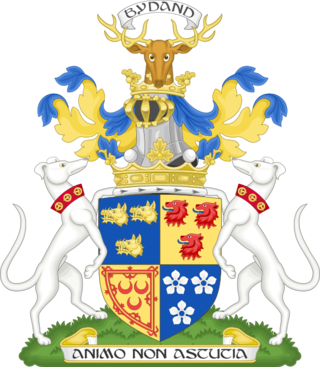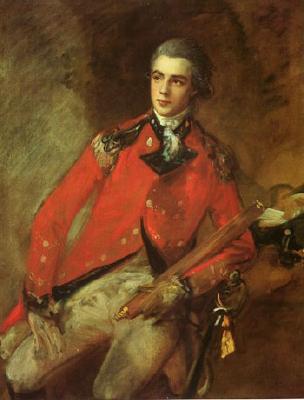
Marquess of Aberdeen and Temair, in the County of Aberdeen, in the County of Meath and in the County of Argyll, is a title in the Peerage of the United Kingdom. It was created on 4 January 1916 for John Hamilton-Gordon, 7th Earl of Aberdeen.

Earl of Cork is a title in the Peerage of Ireland, held in conjunction with the Earldom of Orrery since 1753. It was created in 1620 for Richard Boyle, 1st Baron Boyle. He had already been created Lord Boyle, Baron of Youghal, in the County of Cork, in 1616, and was made Viscount of Dungarvan, in the County of Waterford, at the same time he was given the earldom. These titles are also in the Peerage of Ireland.

Earl of Sandwich is a noble title in the Peerage of England, held since its creation by the House of Montagu. It is nominally associated with Sandwich, Kent. It was created in 1660 for the prominent naval commander Admiral Sir Edward Montagu. He was made Baron Montagu of St Neots, of St Neots in the County of Huntingdon, and Viscount Hinchingbrooke, at the same time, also in the Peerage of England. The viscountcy is used as the courtesy title by the heir apparent to the earldom. A member of the prominent Montagu family, Lord Sandwich was the son of Sir Sidney Montagu, youngest brother of Henry Montagu, 1st Earl of Manchester, and Edward Montagu, 1st Baron Montagu of Boughton.

Duke of Atholl, named after Atholl in Scotland, is a title in the Peerage of Scotland held by the head of Clan Murray. It was created by Queen Anne in 1703 for John Murray, 2nd Marquess of Atholl, with a special remainder to the heir male of his father, the 1st Marquess.

Marquess of Huntly is a title in the Peerage of Scotland that was created on 17 April 1599 for George Gordon, 6th Earl of Huntly. It is the oldest existing marquessate in Scotland, and the second-oldest in the British Isles; only the English marquessate of Winchester is older. The Marquess holds the following subsidiary titles: Lord Gordon of Strathaven and Glenlivet and Earl of Aboyne, and Baron Meldrum, of Morven in the County of Aberdeen.

Marquess of Linlithgow, in the County of Linlithgow or West Lothian, is a title in the Peerage of the United Kingdom. It was created on 23 October 1902 for John Hope, 7th Earl of Hopetoun. The current holder of the title is Adrian Hope.

Earl of Rothes is a title in the Peerage of Scotland. It was created in 1458 for George Leslie, 1st Lord Leslie. He had already been created Lord Leslie in 1445, also in the Peerage of Scotland. His grandson, the third Earl, having only succeeded his elder brother in March 1513, was killed at the Battle of Flodden on 9 September of the same year. His son, the fourth Earl, served as an Extraordinary Lord of Session. Lord Rothes was also tried for the murder of Cardinal Beaton but was acquitted.

Earl of Stair is a title in the Peerage of Scotland. It was created in 1703 for the lawyer and statesman John Dalrymple, 2nd Viscount of Stair.

Earl of Mansfield, in the County of Nottingham, and Earl of Mansfield, in the County of Middlesex, are two titles in the Peerage of Great Britain that have been united under a single holder since 1843.

Earl of Kilmorey is a title in the Peerage of Ireland. It was created in 1822 for Francis Needham, 12th Viscount Kilmorey, a General in the British Army and former Member of Parliament for Newry. He was made Viscount Newry and Mourne, in the County of Down, at the same time, also in the Peerage of Ireland.

Lord Elphinstone is a title in the Peerage of Scotland created by King James IV in 1510.

Earl of the County of Mayo, usually known simply as Earl of Mayo, is a title in the Peerage of Ireland created, in 1785, for John Bourke, 1st Viscount Mayo. For many years he served as "First Commissioner of Revenue" in Ireland. He had already been created Baron Naas, of Naas in the county of Kildare, in 1776, and Viscount Mayo, of Moneycrower in the county of Mayo, in 1781, also in the Peerage of Ireland.
Earl of Clancarty is a title that has been created twice in the Peerage of Ireland.

Earl Howe is a title that has been created twice in British history, for members of the Howe and Curzon-Howe family respectively. The first creation, in the Peerage of Great Britain, was in 1788 for Richard Howe, 4th Viscount Howe, but it became extinct upon his death in 1799. The second creation, in the Peerage of the United Kingdom, was in 1821 for Richard Curzon-Howe, 2nd Viscount Curzon, and it remains extant.

General William Schaw Cathcart, 1st Earl Cathcart was a British soldier and diplomat.

John Murray, 5th Duke of Atholl was a duke in the Peerage of Scotland, a British Army officer and a major landowner in Scotland. Declared insane at the age of twenty, he never sat in the House of Lords.

Clan Cathcart is a Lowland Scottish clan.
Charles Alan Andrew Cathcart, the 7th Earl Cathcart, styled Lord Greenock until 1999, is a Scottish peer and Conservative member of the House of Lords and Chief of the Name and Arms of Clan Cathcart.

Louisa, 2nd Countess of Mansfield, was a Scottish noblewoman, who was married twice: first to David Murray, 2nd Earl of Mansfield, and then to The Hon. Robert Fulke Greville.
George Cathcart, 5th Earl Cathcart, styled Lord Greenock until 1911, was a British Army officer and peer.













